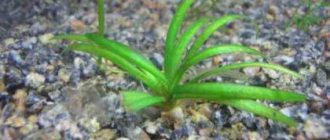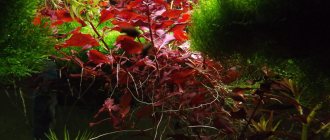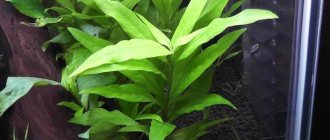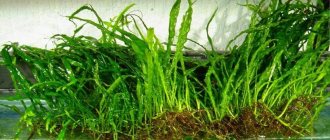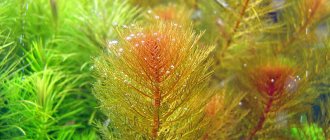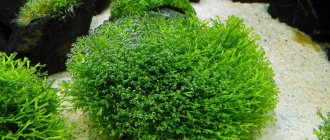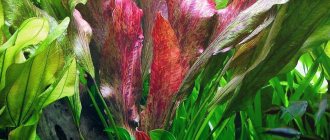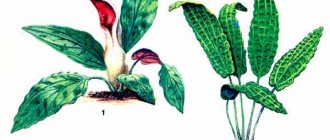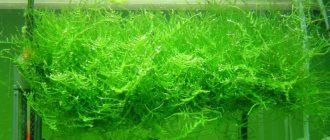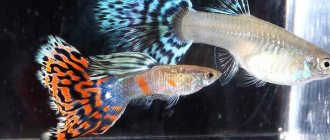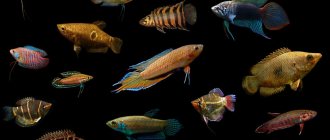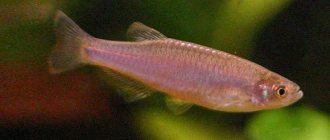This charming aquarium culture is widespread among Russian aquarists. Cabobma is highly appreciated by aquascapers due to its excellent adaptability, high growth rate and low maintenance requirements.
In addition to its excellent decorative qualities, this long-stemmed plant is indispensable when starting an aquarium. It copes well with the typical 1-month outbreaks of nitrogenous compounds. In addition, cabomba is a natural regulator of the biological balance of the aquatic environment.
Description
Cabomba is an aquatic plant of the cabomba family of the water lily family, native to subtropical and tropical waters of South and North America. This fluffy miracle lives at shallow depths in slowly flowing and stagnant warm water areas at a temperature of 18-27 degrees, spreading its furry shoots creeping along the surface over 15-20 meters.
Hydrophyte is undemanding to care, grows abundantly, enriches water bodies with oxygen, absorbs harmful poisons and compounds from the environment, and also plays an important role as shelter for small fish and fry.
Many representatives of the fauna choose cabomba for spawning, spawning eggs in dense foliage, which helps hide them from ill-wishers.
Spreading
Cabomba varieties are primarily native to eastern North and South America. Many species prefer fresh water bodies with stagnant water or slow currents located in moderately warm latitudes.
Appearance
Cabomba is a long-branched herb with succulent, fleshy stems and unusual feathery leaf blades. Each leaf is deeply cut into many thin strips and resembles a fluffy fan. More than 50 such segments are formed on a short leaf petiole, making wave-like movements when the water fluctuates. Opposite leaves are located close to each other on the stem, gathering in groups and giving the shoots a “shaggy” appearance.
Cabomba is a grass with unusual feathery leaf blades.
At the beginning of growth, the shoots have an erect shape and stretch upward. Reaching the surface, they bend and float, then sink to the bottom under their own weight, creating the effect of a fairy-tale coniferous forest. To maintain a neat appearance, the lashes are shortened.
Depending on the variety, cabomba can vary in color from light pink to bright green. Every year, at the very beginning of spring, flower stalks appear in the axils of the leaves. Small yellow flowers, similar to tiny stars, can be either single or collected in inflorescences, located both above the water and in its thickness.
The root system of the plant is fibrous, poorly developed, has fragile roots that can quickly grow over wide areas.
Types of cabombas
Despite their external similarity, different types of cabombas have their own distinctive features.
Caroline
One of the most unpretentious varieties. The crop practically does not branch; its stem stretches upward, growing up to 2 meters, and therefore requires regular cutting. Otherwise, the plant will fill the entire aquarium.
The leaves of the Carolina variety are light green at the base and bright green at the edges. The size of the fan-shaped leaf plate is about 5 cm. They are located on a fleshy round stem, gathering into three-leaf whorls or opposite.
Under favorable conditions, light yellow flowers appear in the upper part of the shoot, rising above the surface of the water.
One of the most unpretentious varieties of kabomba
The plant is very sensitive to light; daylight should last at least 8-12 hours a day with an intensity of 50 Lm/l. Direct sunlight is highly undesirable.
Cabomba Carolina prefers clean, clear water without impurities at a temperature of 22-30 degrees. In the natural environment it lives in both standing and fast-flowing water bodies at a depth of no more than 1.5 meters.
Aquatic (bushy, ordinary)
A variety very similar to the Carolina variety. The main difference is that cabomba aquatica does not branch. And it bears the name “bushy” because it has a quickly spreading, creeping rhizome, from the nodes of which new shoots grow, and the plant looks like a lush bush.
Small (up to 5 cm), feather-shaped leaf blades are located on a long stem and can be colored in various shades from purple to light green. There is also aquatic cabomba that is even yellow in color. When reaching the surface of the reservoir, flower stalks sprout from the axils of the leaves. Flowering lasts about 3 months, replacing one bud with another.
Aquatika also requires regular cutting of long stems and bright lighting 12 hours a day. Otherwise, the foliage becomes sparse, withered, and the hydrophyte loses its pristine beauty.
The bushy species is native to reservoirs in Brazil and Mexico with clean running water. In aquarium life, grass also prefers purified water. Any dregs have a detrimental effect on the “Christmas tree”.
The optimal growing temperature is 22-27 degrees with an average hardness of 8. In harder water, the grass sheds its leaves.
The optimal growing temperature for this species is 22-27 degrees
Furcata red (or cabomba forked)
This purple beauty comes from South America and the Antilles and requires a lot of attention.
Dense stems up to 60 cm in size, red in color, with red-yellow, densely dissected leaves located on them, will best decorate any aquarium. However, as much as cabomba furcata is decorative, it is also demanding. The red variety does not tolerate temperature changes, so it must be constantly maintained at 24-26 degrees.
This is a light-loving plant. Kabomba requires bright light (70 Lm/l) for 12 hours daily. Depending on the level of light, the grass colors the foliage in different shades. It can be yellow-red, purple, lilac-violet, lilac tones. As a rule, the edges of the fan are violet-lilac with yellow splashes; at the base the shade turns yellow-pink.
Furkate needs an enriched substrate and nutritional supplements; the lack of iron has a particularly acute effect.
Hydrophyte does not tolerate changing its place of residence, so its location in the aquarium interior must be thought out in advance.
The forked variety is also demanding of the fauna adjacent to it. The aquarist will have to select fish that do not swarm in the ground, raising sediment from the day and injuring the roots. The culture requires clean, filtered water with acidity within the pH range of 5.5-6.8 and weekly changes.
The forked variety is demanding of the fauna adjacent to it
If all parameters are met, Cabomba piuhgensis will grow by 10 cm every month and will thank the owner with a rich crimson decoration.
Spiral-leaved
An unusual aquarium culture of short stature. In an aquarium, the shoots of Cabomba caroliniana tortifolia do not exceed 30 cm. Such cabomba is usually planted near the side walls. Grass perfectly enriches the water with oxygen and serves as a natural shelter for small inhabitants and a spawning ground for certain species of fish.
The shape of the leaves of this variety deserves special attention. The leaf blade is so finely dissected that it resembles the finest needles that twist into spirals. The heat-loving plant has a light green tint, to which a silver tint is added in bright light. Feels great at a temperature of at least 24 degrees and 12 hours of intense light.
This species thrives in 12 hours of intense light.
The most beautiful
It is not difficult to guess that kabomba got its name due to its spectacular appearance. An essential feature of the variety is the difference in the shape of the leaf plates located in the water and on its surface. Underwater foliage has an opposite arrangement, and surface foliage is alternate.
The floating leaves are light green in color, 4 cm wide, have a coherent structure, while the underwater leaves have a dissected fan-shaped shape and are twice as large. Above, their shade can vary from olive to reddish, below – pink-red. Flowering begins with the appearance of buds with medium-sized purple flowers from the leaf axils.
This aquarium culture comes from the southeastern reservoirs of North America, grows at a temperature of 20-28 degrees, like its other counterparts, it requires intense lighting for at least 12 hours a day. The grass will respond gratefully to two hours of diffused sunlight.
Cabomba the Beautiful grows at a temperature of 20-28 degrees
Demanding on rigidity, at values above 4 it stops growing, gradually dying. The most beautiful representative is rooted closer to the back wall of the aquarium, immediately in the right place, since the culture does not like transplantation.
Paleformis
Perhaps the easiest variety to grow comes from stagnant and slow-flowing reservoirs of Central America. The shoots of the hydrophyte stretch up to 1 meter in length and bush abundantly.
The culture easily tolerates changing environmental conditions and can withstand significant fluctuations in hardness and acidity parameters. Feels good in tropical aquariums with a temperature of 26-33 degrees. Unlike other members of the family, it does not require bright lighting. The color palette varies from yellow-green to dark purple. Flowering begins with the appearance of small (up to 6 mm) white flowers and ends with the formation of tiny seeds (2 mm in size).
The crop must be planted in nutritious enriched soil. The plant requires regular supplies of carbon dioxide, which it happily absorbs. Cabomba paleformis can be called the natural “lungs” of water bodies. The water in them remains crystal clear.
The culture easily tolerates changing environmental conditions
It is easy to root paleformis with layering, which, when in contact with the substrate, soon produces roots.
Growing conditions
The contents of all types of cabomba have common features with the exception of some individual characteristics. However, most of them require standard aquarium care.
Aquarium volume
The hydrophyte has no special wishes regarding the volume of the vessel. It should be taken into account that varieties with long stems (1-2 m) are recommended to be planted in large containers of at least 100 liters. With a smaller volume, the Christmas tree shoots will have to be shortened frequently.
It is best to place the fluffy beauty close to the side and back walls, leaving enough space for the free movement of aquarium inhabitants.
Cabomba with long stems is best planted in containers of at least 100 liters
Water parameters
Depending on the variety, cabomba grows both in a tropical aquarium at a temperature of 22-28 degrees, and in a moderate one at a temperature of 18-22 degrees.
The hardness level should not be higher than 8. However, some species do not do well at levels above 4. In hard water, the foliage of the herringbone becomes smaller, has a brownish, unsightly appearance, the growth of the entire plant stops, and it may die. Acidity levels should be in the range of 5.5-6.8.
The plant needs clean water without excess sediment. Any dregs settle on the feathery leaves of the crop, which soon fall off from excess weight. 1/3 of the volume is replaced weekly.
By the appearance of the grass it is easy to understand whether the surrounding conditions are favorable for it. If the kabomba begins to lose its decorative effect, fade, or fall leaves, you should check the compliance of the environmental parameters.
Lighting
Cabomba can appear in all its glory only with proper lighting. Good light will give the foliage bright reddish shades, the plant will be more “stocky” and fluffy. Hydrophyte is illuminated for about 12 hours a day with fluorescent lamps, incandescent lamps, and also diffused sunlight (but no more than 2 hours a day). Direct exposure to ultraviolet radiation should be avoided. The optimal lighting level is 60 Lm/liter.
The plant is illuminated about 12 hours a day with fluorescent lamps
With the wrong level of illumination, the stems of the fluffy beauty begin to stretch, the distance between the leaves increases, forming voids, and the foliage itself turns pale.
Priming
Since this grass has thin spreading roots, fine and medium fraction soil 5-6 cm thick, for example sand or small pebbles, is suitable as a substrate. This foundation will help the root system to develop well. In a coarse-grained substrate, the roots will spread poorly, and the culture will take a long time and take root poorly.
The soil should be well silted. If the aquarium is new, then specialized fertilizers are added to enrich the substrate.
Recommendations
This plant is perfect for an aquarium of any size and almost any biotope. It is usually planted in groups of 3-7 plants; you can start with a single specimen, and then cut off the top and place it in the ground. An excellent mid-ground and background plant that provides a sense of depth to the aquarium space. Well suited as a refuge for small fish, as well as a spawning ground. To give the plant the desired shape and branching of the shoot, you can pinch off its tip.
Do you need fertilizing and fertilizers?
The main source of nutrition for the underwater “Christmas tree” is its highly dissected foliage, which is capable of absorbing useful substances from the environment. In addition, the culture perfectly absorbs organic matter from silted soil, as well as from fish food that falls to the bottom.
No specialized fertilizing is required. However, the flora will gratefully respond to additional portions of carbon dioxide, as well as to root fertilizers. For these purposes, red clay formed into balls or specialized root tablets are used, which are placed on the bottom near the spreading rhizome. Additional nutrition will strengthen the plant and give it a beautiful and healthy appearance.
The plant can be fed with red clay formed into balls
Reviews
Only after planting did Furkata appreciate the aesthetic beauty of the aquarium. The underwater world sparkles with new colors, and fish happily spawn in the shade of the plant. Now I dream of a large aquarium that is suitable for growing 2-3 types of cabombas.
Many people decorate aquariums. But not everyone finds suitable flora for this. Therefore, it is worth paying attention to kabomba. Just a little attention, basic care and maintenance, rapid growth and reproduction will interest even the most experienced aquarist.
Why isn't it growing?
Despite her unpretentiousness and all her efforts, a fluffy beauty cannot always please you with its full development. Stunted growth can be caused by several reasons:
- Insufficient or excessive light levels.
- Inconsistency of water parameters such as hardness, acidity and temperature.
- The presence of mechanical impurities in the water that settle on the delicate “fingers” of the leaves. The water must be clean, without suspended matter.
- Unsuitable neighboring flora and fauna. For example, the presence of vegetation-eating snails in the aquarium or the growth of blue-green protozoan algae suppresses the growth of cabomba.
- Planting the rhizome too deeply, leading to rotting of the root system.
When negative factors are eliminated, the shaggy cabomba will again take on an attractive appearance.
Benefits for the aquarium
Cabomba is used in the aquarium not only for decoration. Other functions of the plant:
- participation in metabolism;
- favorable conditions for spawning;
- shelter for fry;
- water filter;
- absorption of toxins;
- protection of the aquarium from lime deposits.
Some aquarists claim that cabomba releases substances that are harmful to fish. Based on these assumptions, it is recommended to limit the space occupied by the crop to 40%.
Reproduction
All types of cabomba are propagated vegetatively by cuttings and dividing the rhizome.
The best suited for cuttings are apical shoots with several whorls of leaves, which, after pinching off, quickly produce roots directly in the ground or floating in water, and then easily take root when planted. Cuttings taken from the middle part take much longer to root and their survival rate is lower.
Cabomba propagates vegetatively by cuttings
For quick rooting, it is recommended to take the lower part of the shoot with even a small root. The chances of survival of such a cutting will be great.
When propagating by rhizome, 1/3 of the volume is separated from the main root and the resulting material is divided into several parts with the obligatory presence of living buds on each of them. Fragments of the rhizome are placed on the surface of the water surface until the first leaves and shoots begin to sprout from the buds. Then the plant is planted in the ground in a permanent place. Young seedlings tolerate transplantation very poorly.
Numerous new shoots will indicate successful development.
Red relative of the Christmas tree
The Carolina cabomba has one very capricious relative - the furcata cabomba (Cabomba furcata), most often called the red cabomba or forked cabomba. This individual differs from the common aquatic one only in the color of its dissected leaves. But the colors of its leaves are truly amazing - from faded gold, with a red or orange tint, to bright purple with a thick lilac coating. This plant - the red cabomba forked furcata - is so good that it can be an honor for any aquarium, but, alas, as good as it is, it is also capricious!
Landing
When planting cabomba, there are several rules to follow.
The plant should be planted shallowly in a finely dispersed substrate. Part of the rhizome should remain outside to avoid root rot and death of the flora. If the soil is well silted, then additional fertilizing is not needed. If the nutritional value of the substrate is low, pieces of red clay are added to the planting site.
The plant should be planted shallowly in a shallow substrate.
To make the new “Christmas tree” fluffy and bushy, the top of the shoot is pinched, stimulating the growth of lateral stems. To fix the young plant at the first stage, it is pressed with a pebble or driftwood. After the root mass has grown, the cabomba is released.
Frequent replanting is unacceptable for this grass. Instead of moving an old specimen with a branched root system to a new location, it is recommended to simply root its apical shoots and remove the mother bush.
Diseases and pests
With proper care, the plant is not susceptible to disease. Kabomba can get into trouble due to errors in maintenance and incorrectly selected neighbors.
So, for example, cabomba cannot be planted in a container where fish that dig through mud live: such living creatures damage the fragile roots of the crop, and the rising suspension settles on the thinnest “fingers” of fan-shaped leaves, weighing them down and preventing the flora from “breathing.” The plant sheds its leaves, withers and is difficult to recover. Various mollusks that feed on vegetation can also damage the decorative appearance of the Christmas tree.
Cabomba should not be planted in a container where mud-digging fish live.
With increased hardness in the reservoir, blue-green algae, which is dangerous for cabomba, actively develops and can ruin the fluffy beauty. Therefore, it is important to maintain a balance of physical and chemical parameters of water.
Frequent pruning and lack of carbon dioxide also cause disease and death. The plant becomes dull, fragile, and loses its foliage.
Plant care tips
Most tips for growing all types of cabomba boil down to maintaining climatic and physicochemical properties at the desired level.
First of all, a powerful filter must be installed in the container to trap the smallest particles. Manually cleaning the delicate leaves of the Christmas tree is impossible; even ancistrus catfish cannot cope with it. The water should be clean, transparent, without particles of mechanical impurities. Every week, at least a quarter of the volume of liquid must be replaced with fresh one.
If aquarium inhabitants need medication therapy, it should be carried out in a separate aquarium. All cabomba species cannot tolerate the presence of copper sulfate, which is contained in fish medicines.
The parameters of hardness and acidity should be monitored and maintained at the level required for the flora, the container should be illuminated for at least 12 hours a day and the thermal regime should be observed.
Water hardness and acidity parameters should be monitored
If you follow all the rules for keeping exotic cabomba, this beautiful swaying grass will not only become a magnificent decorative element of a home pond, but will also fulfill its useful role as a regulator of biological balance in the aquarium, and will also serve as an excellent shelter for its small, defenseless inhabitants.
Do you have cabomba growing in your aquarium? How do you care for her? Share your experience in the comments.
